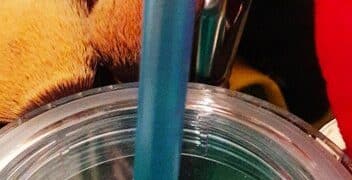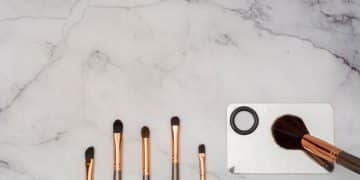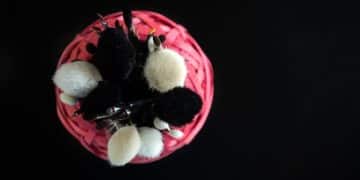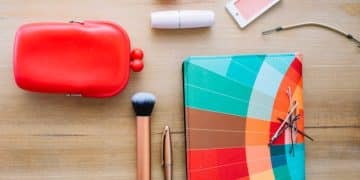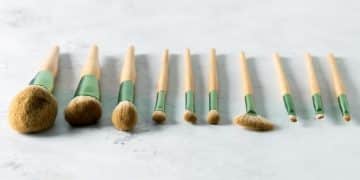Makeup Brush Basics: Your Ultimate Guide to Choosing, Using & Cleaning
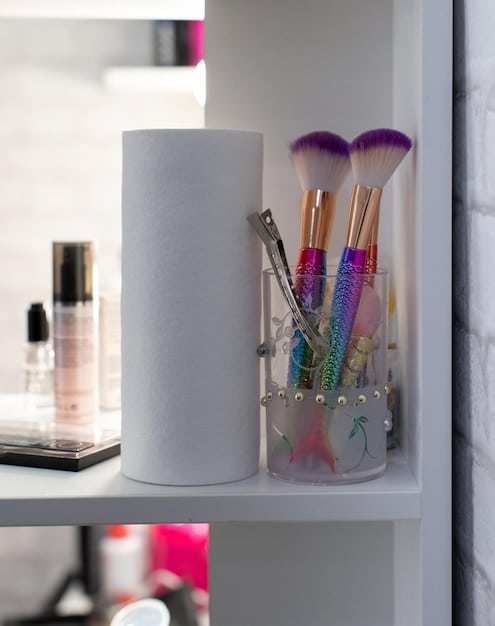
Makeup Brush Basics covers everything from choosing the right brushes for each makeup application, understanding different brush types and materials, mastering proper usage techniques, and maintaining your brushes through effective cleaning methods.
Confused about all those makeup brushes? Our makeup brush basics guide will help you choose the right ones, use them like a pro, and keep them clean for flawless application every time.
Makeup Brush Basics: Understanding Brush Types
Understanding the different types of makeup brushes is the first step in achieving flawless makeup application. Each brush is designed for a specific purpose, and using the right one can make a significant difference in the final look.
From blending eyeshadow to applying foundation, knowing the basics ensures your makeup looks professional and polished.
Foundation Brushes
Foundation brushes are designed to evenly apply foundation for a smooth and flawless complexion. The most common types include flat foundation brushes, stippling brushes, and buffing brushes.
Each type offers a different level of coverage and finish, so understanding their unique characteristics is key.
- Flat Foundation Brush: Provides full coverage with a smooth, even finish. Ideal for liquid and cream foundations.
- Stippling Brush: Creates an airbrushed effect with light to medium coverage. Works well with liquid and cream products.
- Buffing Brush: Blends foundation seamlessly into the skin for a natural, buildable coverage. Best for powder and mineral foundations.
Selecting the right foundation brush depends on your skin type, the type of foundation you use, and the coverage you desire. Experimenting with different brushes can help you find the perfect match that gives you a flawless complexion without streaks or uneven patches.
Essential Brushes for Eyeshadow Application
Eyeshadow application requires a variety of brushes to create different looks, from simple daytime styles to dramatic evening effects. Having the right brushes can improve the blendability and precision of your eyeshadow application.
Essential eyeshadow brushes include shader brushes, blending brushes, and detail brushes.
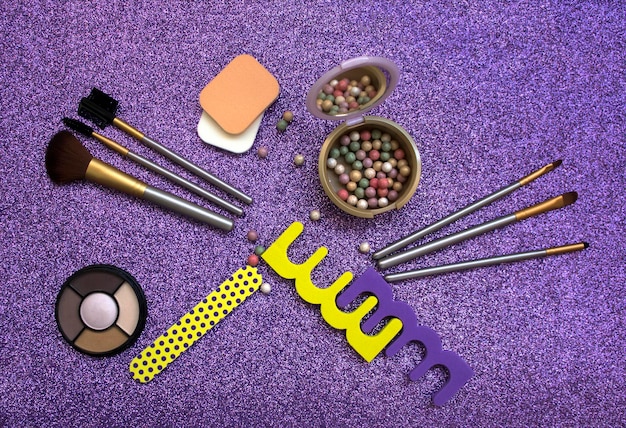
Shader Brushes
Shader brushes are used to apply eyeshadow to the eyelid. They come in various shapes and sizes, each designed for a specific purpose. Flat shader brushes are ideal for packing color onto the lid, while rounded shader brushes are great for blending.
Blending Brushes
Blending brushes are essential for creating a seamless eyeshadow look. These brushes have soft, fluffy bristles that blend different shades together to eliminate harsh lines. Tapered blending brushes are perfect for the crease, while larger blending brushes are great for blending out the edges.
To achieve professional eyeshadow application, select a range of brushes that cater to your specific requirements. With the correct methods, you can produce smooth and faultless eyeshadow looks that improve your eyes.
How to Choose Quality Makeup Brushes
The quality of your makeup brushes can significantly impact the application and overall look of your makeup. Investing in high-quality brushes ensures they last longer and perform better.
When choosing makeup brushes, consider the material of the bristles, the handle, and the overall construction.
- Bristle Material: Natural bristles are ideal for powder products, while synthetic bristles work best with liquid and cream products.
- Handle Material: Look for brushes with sturdy, well-balanced handles made from wood or metal.
- Construction: Check that the bristles are securely attached to the handle and don’t shed easily.
Choosing quality makeup brushes, whether natural or synthetic, will give you better blending, smoother application, and overall improved makeup results. Good brushes are an investment that will pay off every time you use them.
Proper Makeup Brush Usage Techniques
Using makeup brushes correctly can enhance your makeup application and achieve a more professional look. Each brush is designed for a specific technique, and mastering these techniques can elevate your makeup skills.
Understanding the best ways of holding the brush, the amount of pressure to apply, and the direction to move the brush will help you achieve the desired results.
Foundation Application Tips
When applying foundation with a brush, start by applying dots of foundation to your face. Then, use the brush to blend the foundation in a circular motion, starting from the center of your face and working outwards. For a seamless finish, use light, feathery strokes and avoid dragging the brush across your skin.
Eyeshadow Blending Techniques
For eyeshadow blending, use a soft, fluffy blending brush and apply the product in windshield wiper motions in the crease. Avoid applying too much pressure, and gradually build up the color for a smooth, diffused effect. Remember to clean your brush regularly to prevent color buildup.

Mastering these usage techniques and applying the appropriate amount of pressure, you can boost your makeup abilities and make sure a perfect, professional finish every time.
Cleaning Your Makeup Brushes: A Step-by-Step Guide
Cleaning your makeup brushes is essential for maintaining hygiene, preventing breakouts, and ensuring the longevity of your brushes. Dirty brushes can harbor bacteria and lead to skin irritation.
Regular cleaning not only extends the life of your brushes but also ensures that your makeup application is always fresh and flawless.
- Rinse the Bristles: Hold the brush under lukewarm water, ensuring that the water flows downwards to avoid getting water into the ferrule (the part that connects the bristles to the handle).
- Apply Brush Cleanser: Use a gentle brush cleanser or mild soap to clean the bristles. Work the cleanser into the bristles using a brush cleaning mat or your fingers.
- Rinse Thoroughly: Rinse the bristles thoroughly under lukewarm water until all traces of cleanser are gone.
- Reshape and Dry: Gently squeeze out excess water and reshape the bristles. Lay the brushes flat or hang them upside down to dry.
By following this step-by-step guide, you can keep your brushes clean, sanitary, and in prime condition, which will help you get the best results from your makeup application every time.
Maintaining Your Makeup Brushes for Longevity
Proper maintenance of your makeup brushes is crucial for extending their lifespan and ensuring optimal performance. Regular cleaning and careful storage are key components of brush maintenance.
By taking good care of your brushes, you can avoid premature wear and tear and keep them performing like new for years to come.
- Store Brushes Properly: Store your brushes in a brush holder or case to protect them from dust and damage.
- Avoid Harsh Chemicals: Use gentle brush cleansers and avoid harsh chemicals that can damage the bristles.
- Replace Worn Brushes: Replace brushes when the bristles become frayed or start to shed, as they may not perform as well.
Good makeup brush maintenance guarantees that your tools stay in great shape, offering consistent and flawless makeup application. Making an investment in quality brushes combined with appropriate maintenance will save you money in the long run by reducing the need for frequent replacements.
| Key Point | Brief Description |
|---|---|
| ✨ Brush Types | Different brushes for foundation, eyeshadow, and more. |
| 🧽 Cleaning | Regular cleaning prevents bacteria and extends brush life. |
| ✅ Usage | Proper techniques for flawless application. |
| 💰 Quality | Invest in quality brushes for better results. |
Frequently Asked Questions
▼
You should clean your makeup brushes at least once a week, or more often if you use them daily. Regular cleaning prevents bacteria buildup and ensures a flawless makeup application.
▼
Lay your makeup brushes flat on a clean towel or hang them upside down to dry. Avoid standing them upright, as water can seep into the ferrule and damage the bristles.
▼
Yes, you can use baby shampoo to clean your makeup brushes. It’s gentle and effective at removing makeup residue without damaging the bristles. Make sure to rinse thoroughly.
▼
If your makeup brushes start to shed bristles, become frayed, or no longer apply makeup evenly, it’s time to replace them. Quality brushes, when cared for, can last for years.
▼
Natural brushes are best for powder products as they pick up and distribute powder well. Synthetic brushes excel with liquids and creams because they don’t absorb the product.
Conclusion
Mastering the makeup brush basics empowers you to enhance your beauty routine. By understanding brush types, usage techniques, cleaning methods, and maintenance, you can achieve flawless makeup applications and extend the life of your essential tools. Invest in quality, care for your brushes, and elevate your makeup game.
